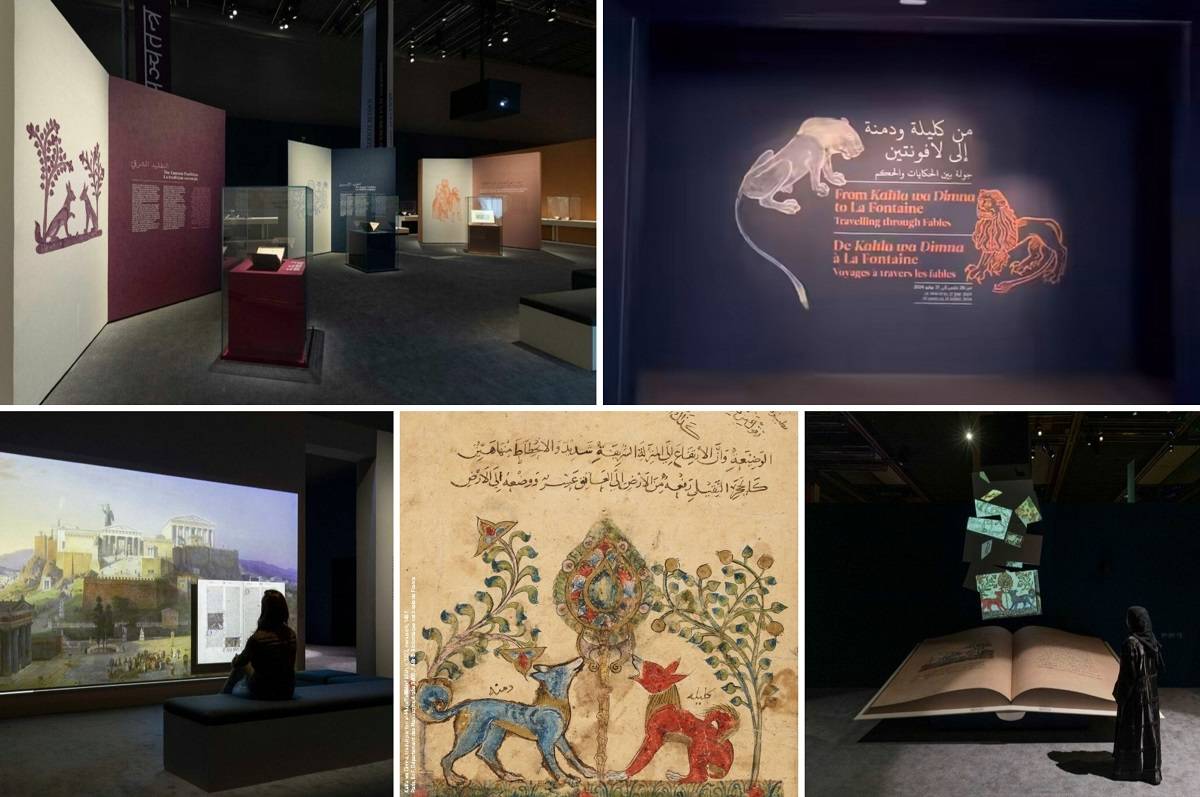
Louvre Abu Dhabi’s first exhibition of 2024 is now open to the public
With more than 132 artworks on display, the exhibition features an eclectic collection of rare manuscripts, paintings, contemporary works, and more — unveiling the timeless narratives of friendship, loyalty, cunning, and morality, as portrayed through anthropomorphic animal characters.
ArtDayME: Louvre Abu Dhabi, one of the region’s leading cultural institutions, has announced the opening of its first exhibition of the year, ‘From Kalīla wa Dimna to La Fontaine: Travelling through Fables’, following its inauguration by H.E. Mohamed Khalifa Al Mubarak, the museum’s Chairman. Held in partnership with Bibliothèque nationale de France and France Muséums along with the generous support of Van Cleef & Arpels, this groundbreaking exhibition showcases a remarkable collection of ancient tales and illustrated fables, promising to captivate visitors as they embark on a unique journey through time.
Curated by Annie Vernay-Nouri, Former Chief Curator, Oriental Manuscripts Department, Bibliothèque nationale de France, the exhibition draws inspiration from traditional illustrated fables and delves into the mystical world of animal tales embedded within historical manuscripts. With more than 132 artworks on display, the exhibition features an eclectic collection of rare manuscripts, paintings, contemporary works, and more — unveiling the timeless narratives of friendship, loyalty, cunning, and morality, as portrayed through anthropomorphic animal characters.
Fables are a genre of literature that typically consists of short stories featuring animals or inanimate objects that possess human-like qualities. These stories often convey moral lessons and teach readers about human behavior through the actions and interactions of the characters. Fables have been passed down through generations and are found in various cultures around the world. They serve as a means of entertainment as well as a way to impart wisdom and values to readers.

The exhibition traces the origins of this genre in India and Greece, following its evolution through the contributions of two key figures: Aesop in the Greco-Roman world and Ibn al-Muqaffa in the Arab-Islamic world. It highlights how the Arabic translation of Ibn Al-Muqaffa (c.720-756 CE) played a pivotal role in the translations that followed, such as the Persian and French versions that Jean de La Fontaine based his translations on. La Fontaine (1621-1695 CE) is widely recognised as one of the most prominent literary figures in French history and his unique works have left a lasting impact on French literature, celebrated to this day for their timeless charm and wit.

Manuel Rabaté, Director, Louvre Abu Dhabi, said: “At Louvre Abu Dhabi, we are not just presenting art; we are weaving narratives as a universal museum, leading by storytelling. Fables have transcended linguistic and cultural boundaries, inspiring new creations in both the East and the West, perfectly aligning with our mission—shedding light on the shared stories of humanity.”
He added: “Our partnership with Bibliothèque nationale de France and France Muséums as well as our collaborations with regional institutions have been invaluable and brought forth incredible loans. This exhibition also presented a wonderful opportunity to collaborate with Abu Dhabi Arabic Language Center, seamlessly enhancing the cultural richness of this fascinating narrative.”

Annie Vernay-Nouri, Former Chief Curator, Oriental Manuscripts Department, Bibliothèque nationale de France, said: “For the first time, visitors have a unique opportunity to witness and compare rare and precious artworks representing three distinct traditions of fables. The Eastern and Western traditions, rooted in a shared universal heritage, have evolved independently without direct contact, each charting its own course. It is only through the works of the eminent fabulist Jean de La Fontaine that these traditions have finally converged and united in a singular collection showcased at Louvre Abu Dhabi.”

Dr. Guilhem André, Acting Director for Scientific, Curatorial and Collections Management, Louvre Abu Dhabi, said: "We are excited to bring this unique and thought-provoking exhibition to Louvre Abu Dhabi, showcasing the timeless power of fables from different cultures and eras. Through this exhibition, visitors will have the opportunity to explore the universal themes and lessons found in these stories and understand the significance they hold in shaping our world.”

The exhibition is divided into three main sections – Travelling Tales, Telling Stories, and The Fables Today – taking visitors on a voyage of texts over time through their various adaptations and translations. Several prominent pieces from France, Saudi Arabia, and the United Arab Emirates will be showcased throughout.
Notable loans from Louvre Abu Dhabi’s partners include one of the oldest illustrated manuscripts of Kalīla wa Dimna, by Ibn al-Muqaffa dating back to the Ayyubid dynasty (1171-1250 CE); The Two Adventurers and the Wondrous Writ by Jean-Baptiste Oudry, draughtsman Bonaventure Louis Prévost; Portrait of Jean de La Fontaine by Émile Bayard, draughtsman L. Wolff (engraver); and La Fontaine composant ses fables [La Fontaine writing his fables] by François Vayron, engraver.
 As part of the museum's continuous efforts to offer its visitors compelling and engaging experiences, Louvre Abu Dhabi is utilising artificial intelligence for the first time within the mediation devices for this exhibition, allowing visitors to create their own fable via touch tables and download their composition by scanning a QR code. Visitors can customise their fables by selecting characters and the moral of the story, which they can keep and share with their children and loved ones.
As part of the museum's continuous efforts to offer its visitors compelling and engaging experiences, Louvre Abu Dhabi is utilising artificial intelligence for the first time within the mediation devices for this exhibition, allowing visitors to create their own fable via touch tables and download their composition by scanning a QR code. Visitors can customise their fables by selecting characters and the moral of the story, which they can keep and share with their children and loved ones.

LEAVE A RELPY